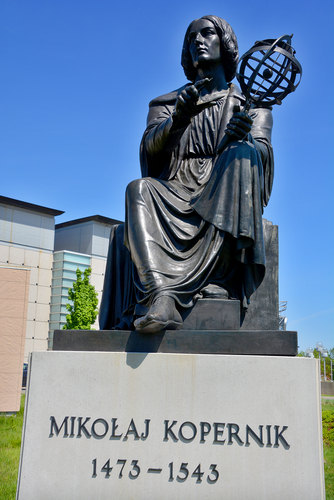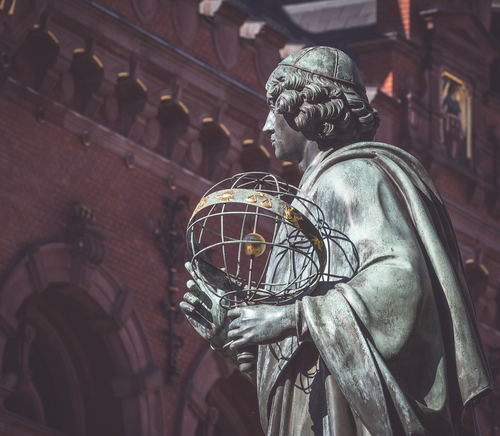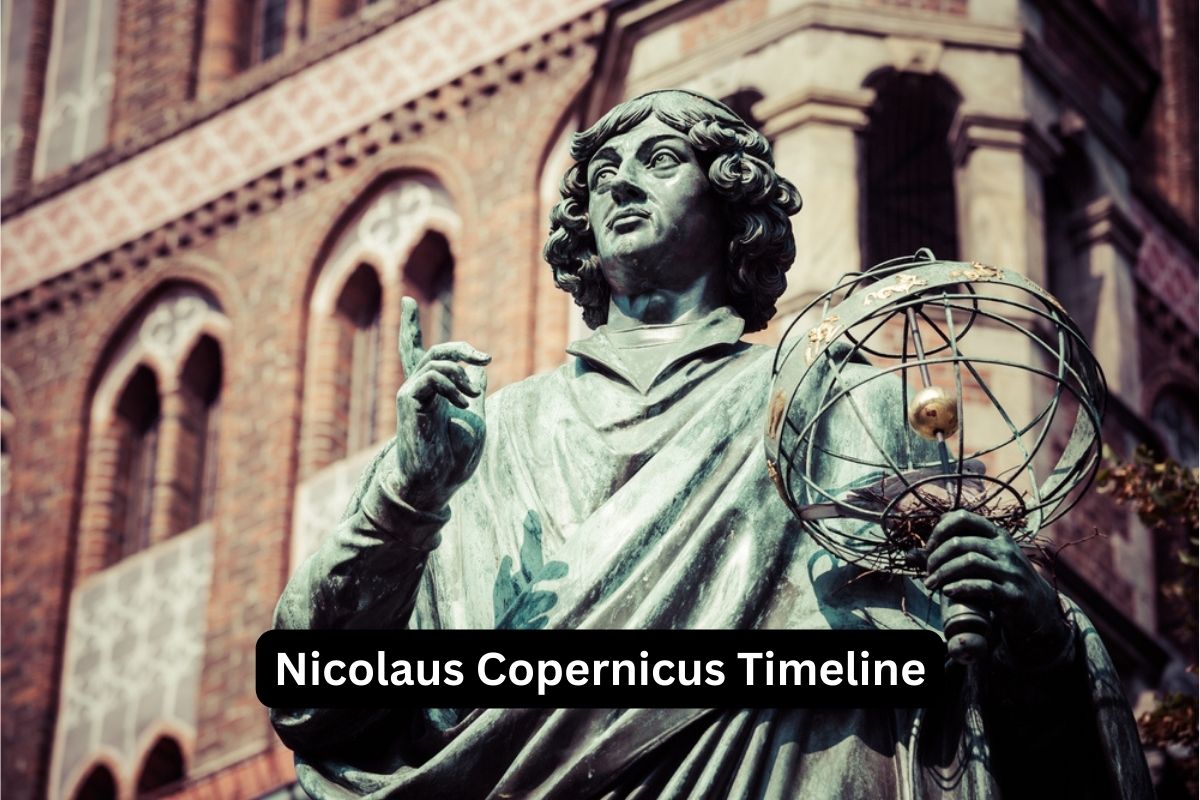Nicolaus Copernicus (1473–1543) was a Polish astronomer and mathematician who proposed a heliocentric model of the universe, challenging the established geocentric model which posited Earth as the center.
His groundbreaking work ignited what would later be known as the Copernican Revolution, a crucial aspect of the larger Scientific Revolution in Europe.
Born into a well-off merchant family, Copernicus studied various subjects including mathematics, philosophy, and canon law at universities in Poland and Italy. Despite working in church administration and practicing medicine, he devoted considerable time to his astronomical pursuits.
Copernicus’s most significant work, “De revolutionibus orbium coelestium” (“On the Revolutions of the Heavenly Spheres”), was published just before his death in 1543. In it, he argued that the Sun, not the Earth, was the center of the universe, a revolutionary idea that was controversial at the time.
Despite initial resistance, Copernicus’s heliocentric model eventually became widely accepted, forever changing our understanding of the cosmos.
| Year | Event |
|---|---|
| 1473 | Nicolaus Copernicus is born on February 19 in Toruń, Poland. |
| 1491-1495 | Copernicus studies at the University of Cracow (Krakow) where he develops an interest in astronomy. |
| 1496-1501 | Copernicus studies canon law and medicine at the University of Bologna in Italy. Works as an assistant to Domenico Maria Novara da Ferrara, an astronomy professor. |
| 1503 | Copernicus earns a doctorate in canon law from the University of Ferrara. |
| 1504-1510 | Copernicus practices medicine in Heilsberg while pursuing his interests in astronomy and begins developing his heliocentric theory. |
| 1514 | Copernicus presents his initial theories in a manuscript titled “Commentariolus”. |
| 1522 | Copernicus begins writing his book “De revolutionibus orbium coelestium” (“On the Revolutions of the Heavenly Spheres”). |
| 1537 | Copernicus is asked by the King of Poland to help reform the calendar, but his work is not utilized until much later. |
| 1543 | The book “De revolutionibus orbium coelestium” is published. |
| 1543 | Nicolaus Copernicus dies on May 24 in Frombork, Poland. |
Timeline of Nicolaus Copernicus
1473 – Nicolaus Copernicus is born on February 19 in Toruń, Poland
Nicolaus Copernicus is born on February 19 in Toruń, a city in northern Poland. He is born into a well-off merchant family.
Also Read: Nicolaus Copernicus Accomplishments
His father, also named Nicolaus, was a successful copper merchant, and his mother, Barbara Watzenrode, came from a prominent family of merchants and city councillors.

1491-1495 – Copernicus studies at the University of Cracow (Krakow) where he develops an interest in astronomy
Copernicus begins his formal education at the University of Cracow (now known as Jagiellonian University). Here, he studies a variety of subjects including Latin, mathematics, astronomy, geography, and philosophy.
Also Read: Galileo Galilei Facts
It’s during this period that he develops an interest in astronomy, exposed to works like the “Epitome of the Almagest” by Johann of Głogów which introduces him to the geocentric (Earth-centered) view of the universe.
1496-1501 – Copernicus studies canon law and medicine at the University of Bologna in Italy
Copernicus goes to Italy to study canon law at the University of Bologna. Here, he also studies medicine, Greek, and possibly astrology.
During his stay in Bologna, Copernicus stays at the house of Domenico Maria Novara da Ferrara, the astronomy professor at the university.
He becomes Novara’s disciple and assistant, attending his lectures and participating in his observations.
1503 – He earns a doctorate in canon law from the University of Ferrara
After spending some years in Italy studying various subjects and immersing himself in the intellectual environment, Copernicus earns a doctorate in canon law from the University of Ferrara.
The acquisition of this degree signifies his deepening involvement in church affairs and his stepping stone into a career as a church official.
1504-1510 – Copernicus practices medicine in Heilsberg while pursuing his interests in astronomy
Copernicus returns to his homeland, Poland, after his years of study in Italy. He takes up a position as a canon (church official) in Frombork (Frauenburg), a town in northern Poland.
Meanwhile, he also practices medicine in the nearby city of Heilsberg (now Lidzbark Warmiński), serving as a physician to Bishop Lucas Watzenrode, his uncle.
During this period, he continues to pursue his interests in astronomy. His medical practice and his church responsibilities provide him the financial stability to dedicate time to his studies.
It’s during these years that he begins formulating his groundbreaking heliocentric theory that challenges the prevailing geocentric model of the universe.
1514 – He presents his initial theories in a manuscript titled “Commentariolus” which he circulates among friends
Having developed a fairly comprehensive heliocentric model of the solar system, Copernicus shares this revolutionary concept with a select group of friends and colleagues by presenting a preliminary version of his theory in a manuscript titled “Commentariolus”.
Also Read: Timeline of the Scientific Revolution
It proposes a sun-centered model of the universe, with Earth and other planets orbiting around the sun, marking a dramatic shift from the accepted geocentric model where the Earth was considered the center of the universe.
1522 – Copernicus begins writing his book “De revolutionibus orbium coelestium” (“On the Revolutions of the Heavenly Spheres”)
After further refining his heliocentric theory, Copernicus begins writing his magnum opus, “De revolutionibus orbium coelestium” (“On the Revolutions of the Heavenly Spheres”).
This work elaborates on the ideas first introduced in “Commentariolus”, providing mathematical proofs and detailed observations supporting the heliocentric model.

1537 – He is asked by the King of Poland to help reform the calendar, but his work was not utilized until much later
King Sigismund I of Poland asks Copernicus for help in reforming the calendar, which at the time was not accurately reflecting the length of the year. Copernicus proposes a reform based on lunar cycles, but his work is not adopted at this time. The eventual Gregorian calendar reform that is now in use worldwide was not implemented until 1582.
1543 – The book “De revolutionibus orbium coelestium” is published, detailing his heliocentric theory
“De revolutionibus orbium coelestium” is finally published in the same year as Copernicus’s death. The book is published in Nuremberg, Germany, and it is considered groundbreaking as it challenges the geocentric model of the universe that had been widely accepted for over a millennium.
The book however was not widely accepted initially, and was later listed on the Index of Forbidden Books by the Catholic Church until the ban was lifted in 1758.
1543 – Nicolaus Copernicus dies on May 24 in Frombork, Poland
Nicolaus Copernicus dies on May 24 in Frombork, Poland, shortly after the publication of “De revolutionibus”. His death is reportedly due to a stroke. Copernicus’s revolutionary ideas would posthumously pave the way for future advancements in astronomy and be a crucial part of the scientific revolution.
